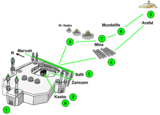Kaaba: Difference between revisions
→Traditional View: Additions |
|||
| Line 130: | Line 130: | ||
{{quote|And remember Abraham and Ishmael raised the foundations of the House (With this prayer): "Our Lord! Accept (this service) from us: For Thou art the All-Hearing, the All-knowing.|Quran|Chapter 2 (Al Bakarah) verse 127<ref name="Cite quran|2|127|t=y|s=ns">{{Cite quran|2|127|t=y|s=ns}}</ref>}} |
{{quote|And remember Abraham and Ishmael raised the foundations of the House (With this prayer): "Our Lord! Accept (this service) from us: For Thou art the All-Hearing, the All-knowing.|Quran|Chapter 2 (Al Bakarah) verse 127<ref name="Cite quran|2|127|t=y|s=ns">{{Cite quran|2|127|t=y|s=ns}}</ref>}} |
||
[[Ibn Kathir]] the famous commentator on the Quran mentions two interpretations among the Muslims on the origin of the Kaaba. One is that the shrine was a place of worship for Angels before the creation of man, later a temple was built on the location by [[Adam]] and [[Eve]] which was lost during the flood in [[Noah]]'s time and was finally rebuilt by [[Abraham]] and [[Ishmael]] as mentioned later in the Quran. Ibn Kathir regarded this tradition as weak and preferred instead the narration by [[Ali ibn Abi Talib]] that although several other temples might have preceded the Kaabah, it was the first "House of God", dedicated solely to Him, built by His instruction and sanctified and blessed by Him as stated in Quran 22:26-29.<ref>{{cite book|title=Tafsir Ibn Kathir on 3:96|url=http://www.altafsir.com/Tafasir.asp?tMadhNo=0&tTafsirNo=7&tSoraNo=3&tAyahNo=96&tDisplay=yes&UserProfile=0&LanguageId=1}}</ref> A [[Hadith]] in Sahih Bukhari states that the Kaaba was the First Mosque on earth, and the Second Mosque was the [[temple of solomon|Temple in Jerusalem]]<ref>{{cite book|title=Sahih Bukhari|location=Book 55, Hadith 585|url=http://www.searchtruth.com/book_display.php?book=55&translator=1&start=0&number=585#585}}</ref>. |
[[Ibn Kathir]] the famous commentator on the Quran mentions two interpretations among the Muslims on the origin of the Kaaba. One is that the shrine was a place of worship for Angels before the creation of man, later a temple was built on the location by [[Adam]] and [[Eve]] which was lost during the flood in [[Noah]]'s time and was finally rebuilt by [[Abraham]] and [[Ishmael]] as mentioned later in the Quran. Ibn Kathir regarded this tradition as weak and preferred instead the narration by [[Ali ibn Abi Talib]] that although several other temples might have preceded the Kaabah, it was the first "House of God", dedicated solely to Him, built by His instruction and sanctified and blessed by Him as stated in Quran 22:26-29.<ref>{{cite book|title=Tafsir Ibn Kathir on 3:96|url=http://www.altafsir.com/Tafasir.asp?tMadhNo=0&tTafsirNo=7&tSoraNo=3&tAyahNo=96&tDisplay=yes&UserProfile=0&LanguageId=1}}</ref> A [[Hadith]] in Sahih Bukhari states that the Kaaba was the First Mosque on earth, and the Second Mosque was the [[temple of solomon|Temple in Jerusalem]]<ref>{{cite book|title=Sahih Bukhari|location=Book 55, Hadith 585|url=http://www.searchtruth.com/book_display.php?book=55&translator=1&start=0&number=585#585}}</ref>. The [[Hajj]] pilgrimage was enjoined by God on the descendants of Ishmael. |
||
According to Islamic tradition, after Ishmael's death, his progeny |
According to Islamic tradition, over the millennia after Ishmael's death, his progeny and the local tribes who settled around the oasis of [[Zam Zam]] gradually turned to polytheism and idolatry. Allah was turned into the head of a [[Pantheon_(religion)|Pantheon]], and several idols were placed within the Kaaba representing deities of different aspects of nature and different tribes. Several heretical rituals were adopted in the the Pilgrimage (Hajj) including doing naked circumambulation.<ref name="Ishaq2">{{Cite book | last = Ibn Ishaq | first = Muhammad | title = Ibn Ishaq's Sirat Rasul Allah - The Life of Muhammad Translated by A. Guillaume | publisher = Oxford University Press | location = Oxford | page = 88-9 | date = 1955 | url = https://archive.org/stream/TheLifeOfMohammedGuillaume/The_Life_Of_Mohammed_Guillaume#page/n67/mode/1up | isbn =9780196360331 }}</ref> |
||
At the culmination of [[Muhammad]]'s mission, at the conquest of Makkah, Muhammad destroyed the idols<ref>{{cite book|title=Sahih Bukhari|location=Book 59, Hadith 583|url=http://www.searchtruth.com/book_display.php?book=59&translator=1&start=0&number=583#583}}</ref> and exiled the polytheists from the vicinity of the Holy City. |
|||
===Pre-Islamic era=== |
===Pre-Islamic era=== |
||
Revision as of 14:21, 20 May 2015
| Kaaba (Ka'aba) | |
|---|---|
الكعبة | |
 The Kaaba Sharif | |
| Religion | |
| Affiliation | Islam |
| Location | |
| Location | Mecca, al-Hejaz, Saudi Arabia |
| Height (max) | 13.1 m (43 ft) |
The Kaaba or Ka'aba (Template:Lang-ar al-Kaʿbah IPA: [ælˈkæʕbɐ], "The Cube"), is a cuboid building at the center of Islam's most sacred mosque, Al-Masjid al-Haram, in Mecca, Saudi Arabia. It is the most sacred site in Islam.[1] Wherever they are in the world, Muslims are expected to face the Kaaba—i.e. when performing salat (prayer). From any point in the world, the direction facing the Kaaba is called the qibla.
Al-Masjid al-Haram was built around the Kaaba.[2]
One of the Five Pillars of Islam requires every Muslim who is able to do so to perform the hajj pilgrimage at least once in their lifetime. Multiple parts of the hajj require pilgrims to make tawaf, the circumambulation seven times around the Kaaba in a counter-clockwise direction. Tawaf is also performed by pilgrims during the umrah (lesser pilgrimage).[1] However, the most interesting times are during the hajj, when millions of pilgrims gather to circle the building on the same day.[3][4] In 2013, the number of pilgrims coming from outside the Kingdom of Saudi Arabia to perform hajj was officially reported as 1,379,531.[5] In 2014, Saudi Arabia reported having completed Hajj permits for 1,389,053 international pilgrims and 63,375 for residents.[6]

Lexicology
The building is known by many names, and Bait al-Ateeq (البيت العتيق Baytu l-'Atīq, "the Ancient House"), referring to its construction by the Prophet Abraham (Ibrahim) in ancient times; Bait Ullah ("House of Allah/God");[7] and Bait al-Haram (البيت الحرام Baytu l-Ḥarām, glossed as Sacred House). The Arabic word Kaaba comes from the Arabic ka'bah meaning "square house," which in turn comes from ka'b, "cube."[8][9] Its equivalent or replica in heaven is traditionally situated above the Kaaba, and is known as Bait al-Ma'mur, which is how Muhammad described it after narrating about his Isra and Mi'raj journey.[10]
Architecture and interior
The Kaaba is a bricked cuboid structure which is made of granite quarried from nearby of Kyara Land. The Kaaba is approximately 13.1 m (43 ft) high (some claim 12.03 m (39.5 ft)), with sides measuring 11.03 m (36.2 ft) by 12.86 m (42.2 ft).[11][12] Inside the Kaaba, the floor is made of marble and limestone. The interior walls, measuring 13 m (43 ft) by 9 m (30 ft), are clad with tiled, white marble halfway to the roof, with darker trimmings along the floor. The floor of the interior stands about 2.2 m (7.2 ft) above the ground area where tawaf is performed.
The wall directly adjacent to the entrance of the Kaaba has six tablets inlaid with inscriptions, and there are several more tablets along the other walls. Along the top corners of the walls runs a green cloth embroidered with gold Qur'anic verses. Caretakers anoint the marble cladding with the same scented oil used to anoint the Black Stone outside. Three pillars (some erroneously report two) stand inside the Kaaba, with a small altar or table set between one and the other two. (It has been claimed that this table is used for the placement of perfumes or other items.) Lamp-like objects (possible lanterns or crucible censers) hang from the ceiling. The ceiling itself is of a darker color, similar in hue to the lower trimming. A golden door—the Babut Taubah (also romanized as Baabut Taubah, and meaning "Door of Repentance")—on the right wall (right of the entrance) opens to an enclosed staircase that leads to a hatch, which itself opens to the roof. Both the roof and ceiling (collectively dual-layered) are made of stainless steel-capped teak wood.
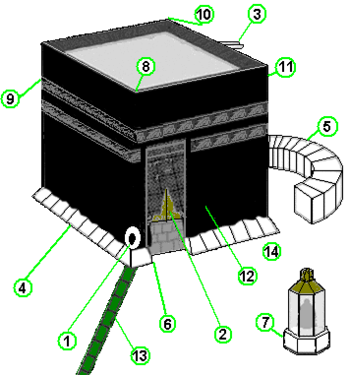
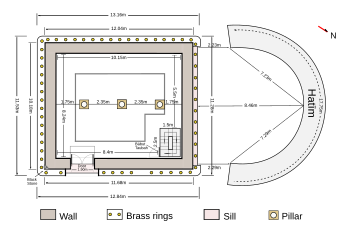

Each numbered item in the following list corresponds to features noted in the diagram image, on right.
- Al-Ħajaru al-Aswad, "the Black Stone", is located on the Kaaba's eastern corner. Its northern corner is known as the Ruknu l-ˤĪrāqī, "the Iraqi corner", its western as the Ruknu sh-Shāmī, "the Levantine corner", and its southern as Ruknu l-Yamanī, "the Yemeni corner".[1][12] The four corners of the Kaaba roughly point toward the four cardinal directions of the compass.[1] Its major (long) axis is aligned with the rising of the star Canopus toward which its southern wall is directed, while its minor axis (its east-west facades) roughly align with the sunrise of summer solstice and the sunset of winter solstice.[13][14]
- The entrance is a door set 2.13 m (7 ft) above the ground on the north-eastern wall of the Kaaba, which acts as the façade.[1] In 1979 the 300 kg gold doors made by chief artist Ahmad bin Ibrahim Badr, replaced the old silver doors made by his father, Ibrahim Badr in 1942.[15] There is a wooden staircase on wheels, usually stored in the mosque between the arch-shaped gate of Banū Shaybah and the Zamzam Well.
- Meezab-i Rahmat, rainwater spout made of gold. Added in the rebuilding of 1627 after the previous year's rain caused three of the four walls to collapse.
- Gutter, added in 1627 to protect the foundation from groundwater.
- Hatim (also romanized as hateem), a low wall originally part of the Kaaba. It is a semi-circular wall opposite, but not connected to, the north-west wall of the Kaaba known as the hatīm. This is 90 cm (35 in) in height and 1.5 m (4.9 ft) in width, and is composed of white marble. At one time the space lying between the hatīm and the Kaaba belonged to the Kaaba itself, and for this reason it is not entered during the tawaf.
- Al-Multazam, the roughly 2 meter space along the wall between the Black Stone and the entry door. It is sometimes considered pious or desirable for a hajji to touch this area of the Kaaba, or perform dua here.
- The Station of Abraham, a glass and metal enclosure with what is said to be an imprint of Abraham's foot. Abraham is said to have stood on this stone during the construction of the upper parts of the Kaaba, raising Ismail on his shoulders for the uppermost parts.[16]
- Corner of the Black Stone (East).
- Corner of Yemen (South-West). Pilgrims traditionally acknowledge a large vertical stone that forms this corner.
- Corner of Syria (North-West).
- Corner of Iraq (North-East). This inside corner, behind a curtain, contains the Babut Taubah, Door of Repentance, which leads to a staircase to the roof.
- Kiswah, the embroidered covering. Kiswa is a black silk and gold curtain which is replaced annually during the Hajj pilgrimage.[17][18] Two-thirds of the way up is a band of gold-embroidered Quranic text, including the Shahada, the Islamic declaration of faith.
- Marble stripe marking the beginning and end of each circumambulation.
- The station of Gabriel.[19]
Religious significance
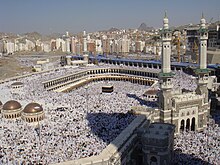
The Kaaba is the holiest site in Islam, and is often called by names such as the House of God or the House of Allah.[20][21]
Qibla
The Qibla is the Muslims' name for the direction faced during prayer.[Quran 2:143–144] It is the focal point for prayer. The direction faced during prayer is the direction of where the Kaaba is.
Pilgrimage
The Haram is the focal point of the Hajj and Umrah pilgrimages[22] that occur in the month of Dhu al-Hijjah in the Islamic calendar and at any time of the year, respectively. The Hajj pilgrimage is one of the Pillars of Islam, required of all able-bodied Muslims who can afford the trip. In recent times, about 6 million Muslims perform the Hajj every year[citation needed].
Some of the rituals performed by pilgrims are symbolic of historical incidents. For example, the incident of Hagar's search for water is emulated by Muslims as they run between the two hills of Safa and Marwah whenever they visit Mecca.
The Hajj is associated with the life of the Islamic prophet Muhammad from the 7th century, but the ritual of pilgrimage to Mecca is considered by Muslims to stretch back thousands of years to the time of Sayyidna Ibrahim (Abraham).
History
Traditional View
The Quran contains several verses regarding the origin of the Kaaba: .
Verily, the first House (of worship) appointed for mankind was that at Bakkah (Makkah), full of blessing, and a guidance for mankind.
— Quran, Chapter 3 (Aale-Imran) verse 96[23]
Behold! We gave the site, to Abraham, of the (Sacred) House, (saying): "Associate not anything (in worship) with Me; and sanctify My House for those who compass it round, or stand up, or bow, or prostrate themselves (therein in prayer).
— Quran, Chapter 22 (Al Hajj) verse 26[24]
And remember Abraham and Ishmael raised the foundations of the House (With this prayer): "Our Lord! Accept (this service) from us: For Thou art the All-Hearing, the All-knowing.
— Quran, Chapter 2 (Al Bakarah) verse 127[25]
Ibn Kathir the famous commentator on the Quran mentions two interpretations among the Muslims on the origin of the Kaaba. One is that the shrine was a place of worship for Angels before the creation of man, later a temple was built on the location by Adam and Eve which was lost during the flood in Noah's time and was finally rebuilt by Abraham and Ishmael as mentioned later in the Quran. Ibn Kathir regarded this tradition as weak and preferred instead the narration by Ali ibn Abi Talib that although several other temples might have preceded the Kaabah, it was the first "House of God", dedicated solely to Him, built by His instruction and sanctified and blessed by Him as stated in Quran 22:26-29.[26] A Hadith in Sahih Bukhari states that the Kaaba was the First Mosque on earth, and the Second Mosque was the Temple in Jerusalem[27]. The Hajj pilgrimage was enjoined by God on the descendants of Ishmael.
According to Islamic tradition, over the millennia after Ishmael's death, his progeny and the local tribes who settled around the oasis of Zam Zam gradually turned to polytheism and idolatry. Allah was turned into the head of a Pantheon, and several idols were placed within the Kaaba representing deities of different aspects of nature and different tribes. Several heretical rituals were adopted in the the Pilgrimage (Hajj) including doing naked circumambulation.[28]
At the culmination of Muhammad's mission, at the conquest of Makkah, Muhammad destroyed the idols[29] and exiled the polytheists from the vicinity of the Holy City.
Pre-Islamic era
Writing in the Encyclopedia of Islam, Wensinck identifies Mecca with a place called Macoraba mentioned by Ptolemy and found in a 3rd-century BC map which suggests that Macoraba was Mecca.[30][31]
In her book, Islam: A Short History, Karen Armstrong asserts that the Kaaba was at some point dedicated to Hubal, a Nabatean deity, and contained 360 idols that probably represented the days of the year. In Guillaume's translation of Ibn Ishaq, an early biographer of Muhammad, the Ka'aba itself was addressed using a feminine grammatical form.[32] Circumambulation was often performed naked by men and almost naked by women,[28] and linked to ancient fertility rites.[33] By Muhammad's day, the Kaaba was venerated as the shrine of Allah, the High God. Once a year, tribes from all around the Arabian peninsula, whether Christian or pagan, would converge on Mecca to perform the Hajj, marking the widespread conviction that Allah was the same deity worshiped by monotheists.[34]
Coloured stones

Imoti[35] contends that there were numerous such "Kaaba" sanctuaries in Arabia at one time, but this was the only one built of stone. The others also allegedly had counterparts of the Black Stone. There was a "red stone", the deity of the south Arabian city of Ghaiman, and the "white stone" in the Kaaba of al-Abalat (near the city of Tabala, south of Mecca). Grunebaum in Classical Islam points out that the experience of divinity of that period was often associated with stone fetishes, mountains, special rock formations, or "trees of strange growth."[36]
The Kaaba was thought to be at the center of the world, with the Gate of Heaven directly above it. The Kaaba marked the location where the sacred world intersected with the profane; the embedded Black Stone was a further symbol of this as a meteorite that had fallen from the sky and linked heaven and earth.[37]
According to Sarwar,[38] about 400 years before the birth of Muhammad, a man named "Amr bin Lahyo bin Harath bin Amr ul-Qais bin Thalaba bin Azd bin Khalan bin Babalyun bin Saba", who was descended from Qahtan and was the king of Hijaz (the northwestern section of Saudi Arabia, which encompassed the cities of Mecca and Medina), had placed a Hubal idol onto the roof of the Kaaba. This idol was one of the chief deities of the ruling Quraysh. The idol was made of red agate and shaped like a human, but with the right hand broken off and replaced with a golden hand. When the idol was moved inside the Kaaba, it had seven arrows in front of it, which were used for divination.[39]
To maintain peace among the perpetually warring tribes, Mecca was declared a sanctuary where no violence was allowed within 20 miles (32 km) of the Kaaba. This combat-free zone allowed Mecca to thrive not only as a place of pilgrimage, but also as a trading center.[40]
Edward Gibbon suggested that the Kaaba was mentioned by ancient Greek writer, Diodorus Siculus, before the Christian era:
The genuine antiquity of Caaba ascends beyond the Christian era: in describing the coast of the Red sea the Greek historian Diodorus has remarked, between the Thamudites and the Sabeans, a famous temple, whose superior sanctity was revered by all the Arabians; the linen or silken veil, which is annually renewed by the Turkish emperor, was first offered by the Homerites, who reigned seven hundred years before the time of Mohammad.
— Edward Gibbon, Decline And Fall Of The Roman Empire, Volume V, pp. 223–224
In Makkan Trade and the Rise of Islam, Patricia Crone argues that the identification of Macoraba with Mecca is false and that Macoraba was a town in southern Arabia in what was then known as Arabia Felix.[41]
Crone was responded to by Amaal Muhammad Al-Roubi in "A Response to Patrica Crone's book".[42]
G. E. von Grunebaum states:
Mecca is mentioned by Ptolemy. The name he gives it allows us to identify it as a South Arabian foundation created around a sanctuary.
— G. E. Von Grunebaum, Classical Islam: A History 600–1258, p. 19
Many Muslim and academic historians stress the power and importance of the pre-Islamic Mecca. They depict it as a city grown rich on the proceeds of the spice trade. Crone believes that this is an exaggeration and that Mecca may only have been an outpost trading with nomads for leather, cloth, and camel butter. Crone argues that if Mecca had been a well-known center of trade, it would have been mentioned by later authors such as Procopius, Nonnosus, or the Syrian church chroniclers writing in Syriac. The town is absent, however, from any geographies or histories written in the three centuries before the rise of Islam.[43]
According to the Encyclopædia Britannica, "before the rise of Islam it was revered as a sacred sanctuary and was a site of pilgrimage."[44] According to German historian Eduard Glaser, the name "Kaaba" may have been related to the southern Arabian or Ethiopian word "mikrab", signifying a temple.[31] Again, Crone disputes this etymology.
Construction attributed to Abraham and Ishmael
The Quran states that Ibrahim, together with his son Ishmael, raised the foundations of a house[Quran 2:127] that is identified by most commentators as the Kaaba. Allah had shown Ibrahim the exact site, very near to the Well of Zamzam, where Ibrahim and Ishmael began work on the Kaaba's construction in circa 2130 BC.[45] After Ibrahim had built the Kaaba, an angel brought to him the Black Stone, a celestial stone that, according to tradition, had fallen from Heaven on the nearby hill Abu Qubays.[46] According to a saying attributed to Muhammad, the Black Stone had "descended from Paradise whiter than milk but the sins of the sons of Adam had made it black".[47] The Black Stone is believed to be the only remnant of the original structure made by Ibrahim.
After the placing of the Black Stone in the Eastern corner of the Kaaba, Ibrahim received a revelation, in which Allah told the aged prophet that he should now go and proclaim the pilgrimage to mankind, so that men may come both from Arabia and from lands far away, on camel and on foot.[Quran 22:27] Going by the dates attributed to the patriarchs, Ishmael is believed to have been born around 2150 BC, with Isaac being born a hundred years later.[46]
Therefore, Islamic scholars have generally assumed that the Kaaba was constructed by Ibrahim around 2130 BC. The Kaaba is, therefore, believed by Muslims to be more than a millennium older than Solomon's Temple in Jerusalem, which is believed to have been finished in 1007 BC.[46] These dates remain consistent with the Muslim belief that the Kaaba is the first and thus oldest mosque in history.[46]
In Samaritan literature, the Samaritan Book of the Secrets of Moses (Asatir) claims that Ishmael and his eldest son Nebaioth built the Kaaba as well as the city of Mecca.[48] "The Secrets of Moses" or Asatir book was suggested by some opinion to have been compiled in the 10th century,[49] while another opinion in 1927 suggested that it was written no later than the second half of the 3rd century BC.[50]
Muhammad's era
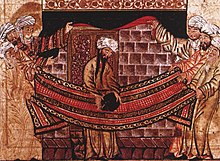
At the time of Muhammad (570–632 AD), his tribe, the Quraysh, was in charge of the Kaaba, which was at that time a shrine containing hundreds of idols representing Arabian tribal gods and other religious figures. Muhammad earned the enmity of his tribe by claiming the Kaaba to be dedicated to the worship of Allah alone and by having all the other idols evicted. The Quraysh persecuted and harassed him continuously, so he and his followers eventually migrated to Medina in 622.[citation needed]
Islamic histories also mention a reconstruction of the Kaaba around 600 AD. A story found in Ibn Ishaq's Sirat Rasūl Allāh, one of the biographies of Muhammad (as reconstructed and translated by Guillaume), describes Muhammad settling a quarrel between Meccan clans as to which clan should set the Black Stone cornerstone in place. According to Ishaq's biography, Muhammad's solution was to have all the clan elders raise the cornerstone on a cloak, after which Muhammad set the stone into its final place with his own hands.[52][53] Ibn Ishaq says that the timber for the reconstruction of the Kaaba came from a Greek ship that had been wrecked on the Red Sea coast at Shu'ayba and that the work was undertaken by a Coptic carpenter called Baqum.[54]
After this migration, or Hijra, the Muslim community became a political and military force, continuously repelling Meccan attacks. In 630 AD, two years after signing the Treaty of Hudaybiyyah, the Meccan Quraysh attacked the Bedouin Khuza'a, thereby breaking the peace treaty. The Muslims emerged as victors in the battle that followed this incident and Muhammad entered Mecca with his followers; they proceeded to the Kaaba. He refused, however, to enter the Kaaba while there were idols in it and so sent Abu Sufyan ibn Harb and Mughira ibn Shu'ba to remove them.[55][56][57]
Narrated Ibn Abbas: When Allah's Apostle arrived in Mecca, he refused to enter the Ka'ba while there were idols in it. So he ordered that they be taken out. The pictures of the (Prophets) Ibrahim and Ishmael, holding arrows of divination in their hands, were carried out. The Prophet said, "May Allah ruin them (i.e. the nonbelievers) for they knew very well that they (i.e. Ibrahim and Ishmael) never drew lots by these (divination arrows). Then the Prophet entered the Ka'ba and said. "Allahu Akbar" in all its directions and came out and not offer any prayer therein.
— Sahih Al-Bukhari, Book 59, Hadith 584
The Kaaba was re-dedicated as an Islamic house of worship and henceforth the annual pilgrimage was to be a Muslim rite, the Hajj, with visits to the Kaaba and other sacred sites around Mecca.[58]
After Muhammad

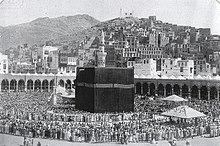
The Kaaba has been repaired and reconstructed many times since Muhammad's day. The structure was severely damaged by fire on 3 Rabi I (Sunday, 31 October 683), during the first siege of Mecca in the war between the Umayyads and Abd-Allah ibn al-Zubayr, an early Muslim who ruled Mecca for many years between the death of ʿAli and the consolidation of Umayyad power. Ibn al-Zubayr rebuilt it to include the hatīm.[59] He did so on the basis of a tradition (found in several hadith collections[60]) that the hatīm was a remnant of the foundations of the Abrahamic Kaaba, and that Muhammad himself had wished to rebuild so as to include it.
The Kaaba was bombarded with stones in the second siege of Mecca in 692, in which the Umayyad army was led by al-Hajjaj ibn Yusuf. The fall of the city and the death of Ibn al-Zubayr allowed the Umayyads under ʿAbdu l-Malik ibn Marwan to finally reunite all the Islamic possessions and end the long civil war. In 693 AD, ʿAbdu l-Malik had the remnants of al-Zubayr's Kaaba razed, and rebuilt on the foundations set by the Quraysh.[61] The Kaaba returned to the cube shape it had taken during Muhammad's time.
During the Hajj of 930 AD, the Qarmatians attacked Mecca, defiled the Zamzam Well with the bodies of pilgrims and stole the Black Stone, taking it to the oasis region of Eastern Arabia known as al-Aḥsāʾ, where it remained until the Abbasids ransomed it in 952 AD. The basic shape and structure of the Kaaba have not changed since then.[62]
After heavy rains and flooding in 1629, the walls of the Kaaba collapsed and the Masjid was damaged. The same year, during the reign of Murad IV, the Kaaba was rebuilt with granite stones from Mecca and the Masjid was renovated.[63] The Kaaba's appearance has not changed since then.
The Kaaba is depicted on the reverse of 500 Saudi Riyal, and the 2000 Iranian rial banknotes.[64]
Cleaning
The building is opened twice a year for a ceremony known as "the cleaning of the Kaaba." This ceremony takes place roughly thirty days before the start of the month of Ramadan and thirty days before the start of Hajj.
The keys to the Kaaba are held by the Banī Shayba (بني شيبة) tribe. Members of the tribe greet visitors to the inside of the Kaaba on the occasion of the cleaning ceremony. A small number of dignitaries and foreign diplomats are invited to participate in the ceremony.[65] The governor of Mecca leads the honoured guests who ritually clean the structure, using simple brooms. Washing of the Kaaba is done twice a year with a mixture made from the Zamzam water, Taif rosewater and expensive Oud oil that is traditionally used in Arabian perfumes.[66] [67]
See also
Notes
- ^ a b c d e Wensinck, A. J; Ka`ba. Encyclopaedia of Islam IV p. 317
- ^ Al-Azraqi. Akhbar Mecca: History of Mecca. p. 262. ISBN 9773411273.
- ^ "In pictures: Hajj pilgrimage". BBC News. December 7, 2008. Retrieved December 8, 2008.
- ^ "As Hajj begins, more changes and challenges in store".
- ^ "Interior Minister Addresses Cable to Custodian of the Two Holy Mosques on Pilgrims". Saudi Arabia Ministry of Foreign Affairs. December 10, 2013. Retrieved August 21, 2014.
- ^ "More than 1.380 million pilgrims arrived". Saudi Arabia Ministry of Foreign Affairs. October 2, 2014. Retrieved October 3, 2014.
- ^ Long, George (1846). The penny cyclopædia. p. 276.
- ^ http://www.etymonline.com/index.php?term=Kaaba
- ^ Akhtar, Mohsin (2008). Oracle of the Last and Final Message. p. 353.
- ^ http://muslimmatters.org/2012/11/15/ten-things-you-didnt-know-about-the-kaaba/
- ^ Peterson, Andrew (1996). Dictionary of Islamic Architecture. London: Routledge.
- ^ a b Hawting, G.R.; Ka`ba. Encyclopaedia of the Qur'an p. 76
- ^ Clive L. N. Ruggles (2005). Ancient astronomy: an encyclopedia of cosmologies and myth (Illustrated ed.). ABC-CLIO. p. 202. ISBN 978-1-85109-477-6.
- ^ Dick Teresi (2003). Lost Discoveries: The Ancient Roots of Modern Science—from the Babylonians to the Maya (Reprint, illustrated ed.). Simon and Schuster. p. 137. ISBN 978-0-7432-4379-7.
- ^ "Saudi Arabia's Top Artist Ahmad bin Ibrahim Passes Away". Khaleej Times. 9 November 2009. Retrieved 15 October 2010.
- ^ According to Muslim tradition: "God made the stone under Abraham's feet into something like clay so that his foot sunk into it. That was a miracle. It was transmitted on the authority of Abu Ja'far al-Baqir (may peace be upon him) that he said: Three stones were sent down from the Garden: the Station of Abraham, the rock of the children of Israel, and the Black Stone, which God entrusted Abraham with as a white stone. It was whiter than paper, but became black from the sins of the children of Adam." (The Hajj, F.E. Peters 1996)
- ^ "'House of God' Kaaba gets new cloth". The Age Company Ltd. 2003. Retrieved 2006-08-17.
- ^ "The Kiswa – (Kaaba Covering)". Al-Islaah Publications. Retrieved 2006-08-17.
- ^ Key to numbered parts translated from, accessed December 2
- ^ The Basis for the Building Work of God - Page 37, Witness Lee - 2003
- ^ Al-Muwatta Of Iman Malik Ibn Ana - Page 186, Anas, - 2013
- ^ Mohamed, Mamdouh N. (1996). Hajj to Umrah: From A to Z. Mamdouh Mohamed. ISBN 0-915957-54-X.
- ^ Quran 3:96 (Translated by Yusuf Ali)
- ^ Quran 22:26 (Translated by Yusuf Ali)
- ^ Quran 2:127 (Translated by Yusuf Ali)
- ^ Tafsir Ibn Kathir on 3:96.
- ^ Sahih Bukhari. Book 55, Hadith 585.
{{cite book}}: CS1 maint: location (link) - ^ a b Ibn Ishaq, Muhammad (1955). Ibn Ishaq's Sirat Rasul Allah - The Life of Muhammad Translated by A. Guillaume. Oxford: Oxford University Press. p. 88-9. ISBN 9780196360331.
- ^ Sahih Bukhari. Book 59, Hadith 583.
{{cite book}}: CS1 maint: location (link) - ^ Marx, edited by Angelika Neuwirth, Nicolai Sinai, Michael (2010). The Qur'an in context historical and literary investigations into the Qur'anic milieu (PDF). Leiden: Brill. pp. 63, 123, 83, 295. ISBN 9789047430322.
{{cite book}}:|first=has generic name (help)CS1 maint: multiple names: authors list (link) - ^ a b Wensinck, A. J; Ka`ba. Encyclopaedia of Islam IV p. 318 (1927, 1978)
- ^ Ibn Ishaq, Muhammad (1955). Ibn Ishaq's Sirat Rasul Allah - The Life of Muhammad Translated by A. Guillaume. The text reads "O God, do not be afraid", the second footnote reads "The feminine form indicates the Ka'ba itself is addressed". Oxford: Oxford University Press. p. 85 footnote 2. ISBN 9780196360331.
- ^ Rice, Edward (May 1978). Eastern Definitions: A Short Encyclopedia of Religions of the Orient. New York: Doubleday. p. 433. ISBN 9780385085632.
- ^ Karen Armstrong (2002). Islam: A Short History. p. 11. ISBN 0-8129-6618-X.
- ^ Imoti, Eiichi. "The Ka'ba-i Zardušt", Orient, XV (1979), The Society for Near Eastern Studies in Japan, pp. 65–69.
- ^ Grunebaum, p. 24
- ^ Armstrong, Jerusalem, p. 221
- ^ Hafiz Ghulam Sarwar. Muhammad the Holy Prophet. pp. 18–19.
- ^ Francis E. Peters, Muhammad and the origins of Islam, SUNY Press, 1994, p109.
- ^ Armstrong, Jerusalem: One City, Three Faiths, p. 221-222
- ^ Crone, Patricia (2004). Makkan Trade and the Rise of Islam. Piscataway, New Jersey: Gorgias. pp. 134–137
- ^ "A Response to Patricia Crone's Book" (PDF). Retrieved 15 October 2010.
- ^ Crone, Patricia (2004). Makkan Trade and the Rise of Islam. Piscataway, New Jersey: Gorgias. p. 137
- ^ Britannica 2002 Deluxe Edition CD-ROM, "Ka'bah."
- ^ Stories of the Prophets, Ibn Kathir
- ^ a b c d Mecca: From Before Genesis Until Now, Martin Lings, Archetype
- ^ Tirmidhi Collection of Hadith
- ^ Gaster, Moses (1927). The Asatir: the Samaritan book of Moses. London: The Royal Asiatic Society. pp. 262, 71.
Ishmaelites built Mecca (Baka, Bakh)
- ^ Crown, Alan David (2001). Samaritan Scribes and Manuscripts. Tübingen: Mohr Siebeck. p. 27.
- ^ M. Gaster, The Asatir: The Samaritan Book of the "Secrets of Moses", London (1927), p. 160
- ^ University of Southern California. "The Prophet of Islam – His Biography". Retrieved August 12, 2006.
- ^ Guillaume, A. (1955). The Life of Muhammad. Oxford: Oxford University Press. pp. 84–87
- ^ Saifur Rahman al-Mubarakpuri, translated by Issam Diab (1979). "Muhammad's Birth and Forty Years prior to Prophethood". Ar-Raheeq Al-Makhtum (The Sealed Nectar): Memoirs of the Noble Prophet. Retrieved 2007-05-04.
- ^ Cyril Glasse, New Encyclopedia of Islam, p. 245. Rowman Altamira, 2001. ISBN 0-7591-0190-6
- ^ Sahih Al-Bukhari Book 59, Hadith 584
- ^ Ashraf, Shahid. 2004. Encyclopaedia of Holy Prophet and Companions, page 357. Anmol Publications PVT. LTD. ISBN 978-81-261-1940-0
- ^ Singh. Longman History & Civics ICSE 7, page 9. Pearson Education India. ISBN 978-81-317-2887-1
- ^ W.M. Flinders Petrie (1915). The Book of History, a History of All Nations From the Earliest Times to the Present. Viscount Bryce (Introduction). The Grolier Society.
{{cite book}}: Unknown parameter|coauthors=ignored (|author=suggested) (help) - ^ Sahih Muslim, 7:3083
- ^ Sahih Bukhari 1506, 1508;Sahih Muslim 1333
- ^ Sahih Bukhari 1509; Sahih Muslim 1333
- ^ Javed Ahmad Ghamidi. The Rituals of Hajj and ‘Umrah, Mizan, Al-Mawrid
- ^ History of the Kaaba
- ^ Central Bank of Iran. Banknotes & Coins: 2000 Rials. – Retrieved on 24 March 2009.
- ^ "Kaaba". Retrieved 15 October 2010.
- ^ Halawani, Eman (June 2014). "Antimicrobial activity of Rosa damascena petals extracts and chemical composition by gas chromatography-mass spectrometry (GC/MS) analysis". African Journal of Microbiology Research. 8 (24): 2359–2367. doi:10.5897/AJMR2014.6829.
- ^ "Washing of Alkaaba with Oud and rosewater". Retrieved 22 March 2015.
References
- Armstrong, Karen (2000,2002). Islam: A Short History. ISBN 0-8129-6618-X.
- Crone, Patricia (2004). Meccan Trade and the Rise of Islam. Piscataway, New Jersey: Gorgias.
- Elliott, Jeri (1992). Your Door to Arabia. ISBN 0-473-01546-3.
- Guillaume, A. (1955). The Life of Muhammad. Oxford: Oxford University Press.
- Grunebaum, G. E. von (1970). Classical Islam: A History 600 A.D. to 1258 A.D. Aldine Publishing Company. ISBN 978-0-202-30767-1.
- Hawting, G.R; Ka`ba. Encyclopaedia of the Qur'an
- Hisham Ibn Al-Kalbi The book of Idols, translated with introduction and notes by Nabih Amin Faris 1952
- Macaulay-Lewis, Elizabeth, The Kaba" (text), Smarthistory.
- Mohamed, Mamdouh N. (1996). Hajj to Umrah: From A to Z. Amana Publications. ISBN 0-915957-54-X.
- Peterson, Andrew (1997). Dictionary of Islamic Architecture London: Routledge.
- Wensinck, A. J; Ka`ba. Encyclopaedia of Islam IV
- [1915] The Book of History, a History of All Nations From the Earliest Times to the Present, Viscount Bryce (Introduction), The Grolier Society.

